For almost as long as ZZT has been around, Alexis Janson has been hailed as one of the greatest ZZTers there ever was. From her classic adventures, to her groundbreaking experimental works, to her contributions to the ZZT community from studying ZZT's file format and realizing what could be done with it, her name shows up pretty much everywhere you look. Short of Tim Sweeney himself, Janson is easily the most well-known name in ZZT culture.
And yet, she doesn't have a single featured world on the Museum. (...Well, there's a funny story about The Three Trials to get into later.)
This is a legacy issue. The ZZT community in the early and mid 1990s wasn't yet nearly as centralized as it became around the turn of the century. While the ZZT Archive's original Game of the Month Award was open to any game (and the Classic Game of the Month award took over the job once the GotM turned into an award for the best game of a given month), none of Janson's games never received such an award. In the later z2 era, when Featured Games became a way to celebrate the classics, Janson's legacy continued to be ignored.
Even in those years, her biggest three titles Super Tool Kit (STK), Code Red, and Mission: Enigma were still recognized as some of the most important worlds in ZZT. I'm inclined to believe that if there's any reason why these games were never formally recognized in the established ZZT community its because it seemed a little too obvious. It would be like going into a community of sci-fi lovers and asking if they've heard of this "Star Trek" thing. Or heck, I can use the analogy and suggest recommending "Citizen Kane" to some historical film buffs. There's always new things to say about iconic works, but as far as "hey did you know this is a thing you might like?", I think these groups are well aware of these iconic pieces of media.
Here on the Museum, the Featured World list has a slightly expanded scope, serving not just to recommend quality worlds, but to also showcase anything of importance, and by that criteria, the registered version of the Software Visions ZZT Pack is a shoe-in.
This ZZT Pack is a great way to play catch-up on this long overdue status. The pack contains eleven ZZT worlds, one Super ZZT world, documentation, guides, maps, and in its original disk image form, a dedicated installation program. It's easy to forget that Alexis Janson did actually sell copies of this collection. To this day, she is surely responsible for the most sales of a non-official ZZT release.
It's also not just Janson on display here. Software Visions was a ZZT company, and while there's no end to ZZTers who slapped "Productions", "Enterprises", or "Incorporated" onto their names and called it a one-person company, Software Visions also had Matt Williams creating some very high quality work that shouldn't be neglected. His own contributions round out the package with some additional games definitely worth your time as well. Thanks to Janson's early work being so abundant, this compilation might otherwise seem a bit stuck in the past with so many games showing strong inspiration from the worlds of Sweeney and the other official ZZT releases (Best of ZZT and ZZT's Revenge). With the inclusion of Matt's worlds from the mid 90s the pack is instead a celebration of some of the best works seen in ZZT available at the time, even if the "new" in this mix of old and new is still more than twenty-five years old now.
And so, in no particular order, may I present the contents of the Software Vision ZZT Pack.
The Underground Bugtown of ZZT
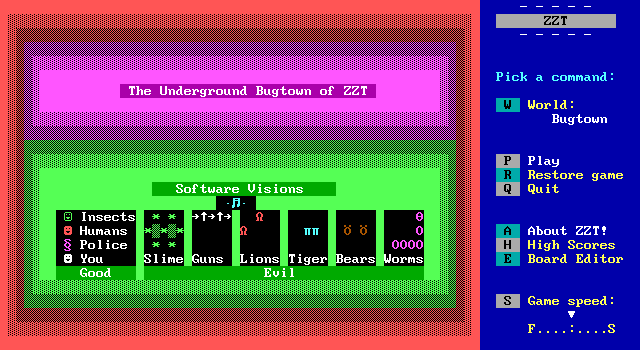
This one is in fact Alexis's first ZZT release, and while it definitely shows in comparison to the quality of her later works, Bugtown is still impressive in its own way. Like many new ZZTers, the first game (or games) you make, tend to be derivative of Town and other official worlds. This one is a bit of a mashup of all the official worlds, with a train from City taking you to the gates of the town where you are promptly locked inside and welcomed to the Dungeons. Those familiar with the original games will feel instantly recognize the origins of several locations. There's the bank, whose vault combination requires pushing sliders, the kennel filled with pockets of ZZT's creatures, and a very Town inspired ending sequence. Sure, the keys are golden rather than purple, but nobody's being fooled here. It's one of many examples of a new author seeing taking the official ZZT worlds as the ideal of what a ZZT world should be, and trying to capture that style themselves.
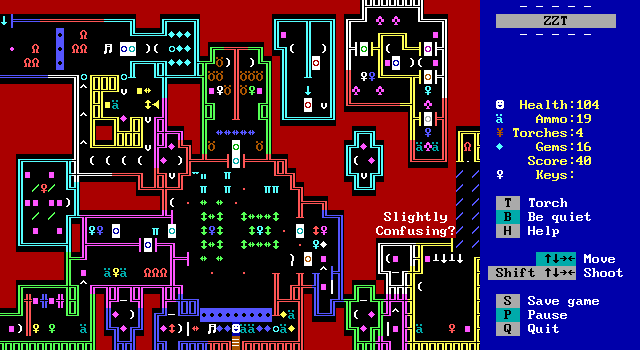
Fans of purple key styled games (Sweeney-likes?) will get a good amount of fun out of this one. Bugtown is quite well made for a style of ZZT world typically plagued by the poor designs of those brand new to game development. While I'd hardly say it's on par with Town itself, there are a few impressive boards for such an early work. The "Slightly Confusing" puzzle is an early example of Janson's uncanny ability to create some very challenging puzzle boards without getting too frustrating. (Of course, you need to have the right keys before you even go in.) The game also shows off some goofy comedic bits such as trying to trick a police officer into looking away by telling them a giant worm is behind them which while intended to be a lie, does spawn in a centipede afterwards. The frustrations of the mayor having to give out his address over a phone call are a surefire smile as well.
It's a game that shows its age in other respects. At one point touching the wrong object before reaching town will fill the board up to the stat limit with tigers. The lake board has nothing on it to benefit the player at all, just water, forest, and spinning guns. This wouldn't be too bad, except it also has no board exits defined, so entering it means having to reload to get around the mistake. Other worlds of Janson's did receive fixes over time, so I get the feeling that by the 1996 date of the disk these worlds arrived on that any interest Janson had in Bugtown was long gone.
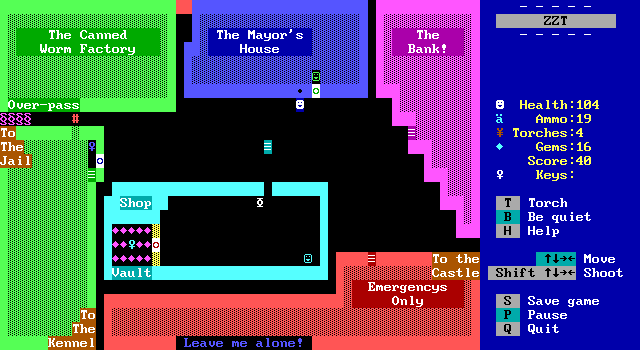
The whole theme of a town populated by anthropomorphic insects isn't utilized all that much either. You'd be forgiven for forgetting that information entirely as it's basically never relevant to anything, mostly functioning as a way to avoid going for broke and calling the game "Town" of ZZT. As Janson's first foray into ZZT, there's a glimpse offered of what's to come. Intricately crafted puzzles, distinct settings, and a love of surprises that will show up again and again in later worlds have their groundwork laid here.
The Five Golden Coins... ZZT Dungeons, Part II
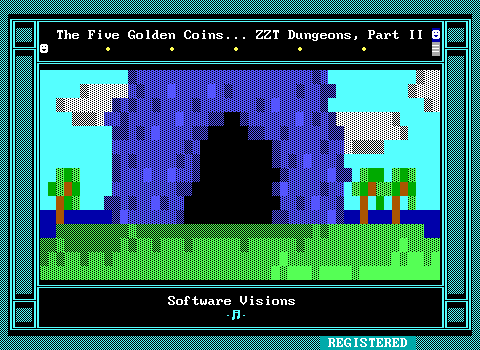
If Bugtown is Town, then what do you suppose Dungeons Part II could be? Yes, this time it's just straight up a fan sequel to Dungeons of ZZT. The connections to the original are fairly limited, and there's no need to have played Dungeons to appreciate this one, which is a streamlined take on the purple key collecting style of game. You have been (once again) thrown into the dungeons. This time by "the boss", who is willing to bargain for your freedom. Find the five golden coins scattered throughout the dungeon and you may use them to purchase your freedom.
The game opens with a menu allowing the player to select between three difficulties. The "cheat mode" will reveal all the hidden bonus objects and black keys, simplify puzzles, at the cost of fewer bonus points and a limited ending. The "difficult mode" adds more monsters, removes some items, and includes a bigger ending with an even larger score bonus.
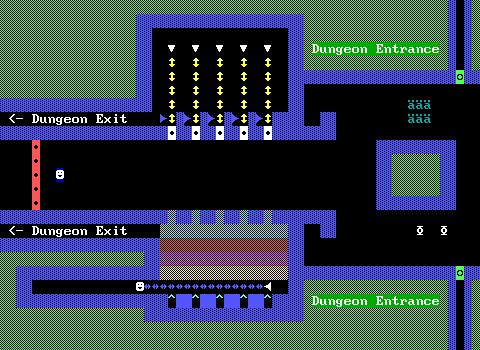
You are then taken to a tweaked version of the iconic opening boards from Dungeons with purple doors replaced with slots to insert the five coins, plus two "black doors" for optional keys that can be found to unlock bonus rooms filled with goodies to collect.
I had only intended to sample the game for the purposes of this article so I could discuss it a little bit, having never really put any serious effort into getting through. I quickly found myself quite invested, going so far as to collect all five coins when I was intending to skim through the game for a refresher. Fans of early ZZT adventures will be right at home here. Janson, while still rather early in her ZZTing career, has made a game which improves on some of the more common flaws of the original worlds while respectfully paying homage to what came before. The dungeon hub is now a series of seven passages that can be entered freely, keeping the original's non-linear structure, while making it quick to navigate. Five of these passages lead to the golden coins while the other two contain the black keys for the bonus rooms. It's a guess as to which is which, but the rewards for the bonus rooms won't leave you feeling like you wasted your efforts.
Plus, there's a vendor in the hub that sells all manner of supplies, something missing from the original Dungeons (and Caves). This shop is rather unique, not just selling supplies, but also allowing the player to sell ammo and torches back to the store. There are also "special offers" to get better value from your purchases when making large orders, making the economics of the game a lot more complicated than most early ZZT worlds. This shop combined with the plentiful amount of gems make it a rare instance of a shop that's actually worth the player's time and money. Health is a critical factor in the original ZZT worlds, but Janson wants the player to succeed rather than stumble. The store's numerous offerings combined with a lack of a trip to get there dramatically decreases the chances of having to start over or reload constantly if your supplies get low.

Janson has a good grasp of making classic ZZT adventure boards here. The "Altar Room" is a personal favorite, turning the usual race against an arbitrary time limit into a race against two giant pistons that slowly extend. If the player can't make it through the board quickly enough, the pistons will reach the coin on the altar and crush it into dust. It's a tense race of collecting keys and not overshooting transporter exits to reach the switch to stop the pistons in time.
Other action scenes feel a little more played out, but while they aren't anything groundbreaking, they tend to be fun to get through and demonstrate a good grasp of how ZZT's components can interact. A dark cave is filled with forests and large centipedes. The player can take their time and wait for gaps in the centipedes before crossing, or they can brush past the edges running the risk of the centipede chasing the player perfectly down the trail they created. Patience seems like the clear winner, but the limited number of torches means there's a trade-off there as well.
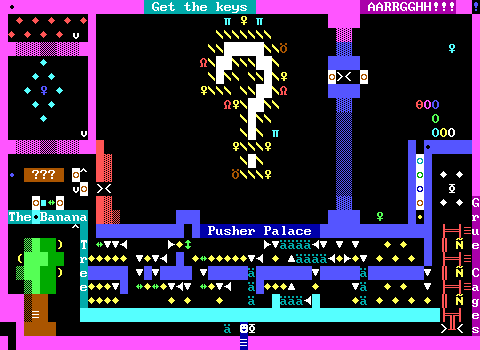
Dungeons Part II also has its share of puzzle boards as well. A complicated looking castle board scared me off from playing it on my little tour, yet it reminded me of some of Janson's later, denser puzzles such as the Thief's Fortress from The Three Trials. Another board opts to ask the player two riddles, which are so well known that they fall completely flat, yet even when they're just a formality, the themeing around them still makes it enjoyable, as several large faces made up of objects discuss how they should try and stump the player making silly looking expressions all the while.
It's not without its share of missteps. For one thing, the version included in this collection actually starts on the wrong board! This isn't the case with any of the archived stand-alone releases. In gameplay, one of the branches is a series of arena boards where duplicators slowly fill the room with enemies while the player has to run around grabbing keys to reach the exit. The boards are too big for the enemies to be a threat, making the path feel like a wasted opportunity. Another board makes the player navigate a simple maze for some keys where the walls are made up of shark infested water. Most of the board works out nicely, with the halls being wide enough that the player is always at risk of a shark passing by, but allowing them to switch from wall to wall and generally navigate safely provided that they're paying attention to their surroundings. Sadly, this gets thrown out at the last moment when one final key does just force the player down two narrow paths where you're always in contact with two rows of water. At that point whether or not the player will be attacked by a shark is entirely random with no way to influence the outcome short of taking ages to lure any sharks there towards less important waters.
It also ends with an "Illusion Maze", of something like eight boards with three passages to choose from. Not fun. I think my negativity towards mazes in ZZT is pretty well-known by this point, so the only thing I can say in favor of it is that at least it's a small room that requires very little time between exiting the previous passage and entering the next.
By the standards of what Janson's entire creative output in ZZT, this may be on the more uninspired side. However, if you look at Dungeons Part II from the perspective of a purple key collecting game, the good definitely outweighs the bad, and the bad is more tedious than aggravating. Many of these boards would have fit right in with the Best of ZZT series's better offerings had the deadline not been long past. Those that find themselves craving more classic set-piece style boards that can be identified by name are in for a treat with this one.
The Three Trials

This time the inspiration is Best of ZZT Part 2: Royal Treasures, at least for the opening. Evil shadows have befallen the land and you are the last hope of the kingdom which has been frozen over. In order to restore the world to balance and defeat evil, you'll have to help the royal wizard recover his wand, orb, and book of spells. And that's just the beginning! The Three Trials is a strangely named game, as there are lot more than three obstacles to overcome in your quest to save all kingdoms from a permanent winter.
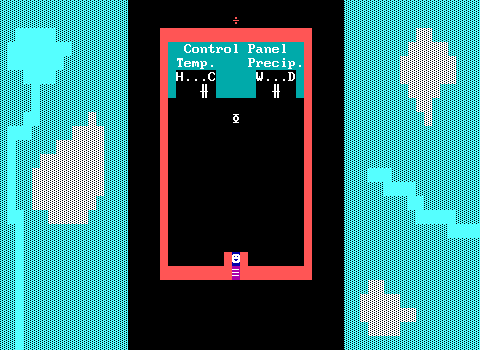
Unlike Janson's other earlier titles, this one has a lot more characterization. You won't just travel from place to place uncovering artifacts. You'll meet with kings of various nations, fight the undead, go scuba diving, and fix the thermostat of the world. While games like Bugtown and Dungeons Part II are content to explain everything that needs to be said in the first few minutes, The Three Trials feels like a world to explore rather than just a series of obstacle filled rooms to challenge ZZTers. It's got its share of humor with golden bananas, an angry princess, and plenty of opportunities to accidentally doom the world you're supposed to be saving. Basically, it has a personality to help tie everything together.
It also has the "Super Rube Board", a nefarious puzzle I've never managed to complete. Good luck to any challengers there.
Of all of Janson's games, I feel this one is the one that got done dirty. Every one of Janson's ZZT releases is looked back at fondly. Rough edges may be there, but given the alternatives of the time, her worlds have always been on the good side of quality. Yet, as mentioned at the start of the article, none of Janson's released ever received a featured game award. The Three Trials is almost an exception. For an April Fool's Day joke back in 2002, an unofficial edit of the game was released renamed to The Fool's Quest and passed off as a long lost Alexis Janson release. In reality, the changes are almost entirely confined to the title screen and opening castle scene, otherwise playing identically to the proper original, and if anybody was fooled, it wouldn't take long for somebody revisiting Janson's titles to realize something was up. While the praise in the review is genuine and applies just as well to this original title, it's still the edit that received the award.
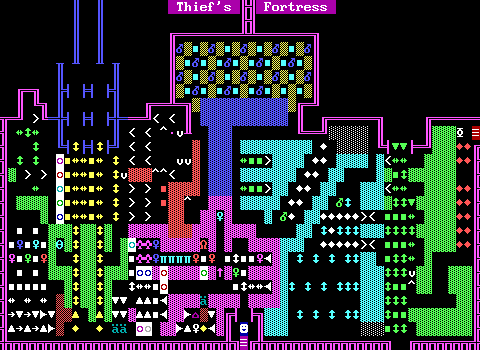
The Thee Trials is definitely one of the more challenging of Janson's worlds with the first act's recovery of the wizard's stolen items requiring some very difficult boards to be completed with almost no supplies. It's very easy to have to cheat or start over in order to keep your health up to be able to get through them all and begin opening up the rest of the world for further exploration.
Your next quest is to recover a number of "Prosek" gems and is actually the bulk of the work for the game. This sees the player negotiating with royalty (sometimes rather poorly) in an attempt to obtain them and set them onto the Prosek altar in a specific way lest the altar be destroyed and the barrier protecting the weather tower remains in place forever.
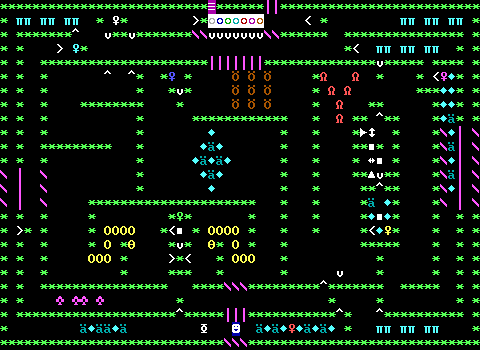
Despite the rocky start, those who stick around long enough to get a better feel of the world will find some of Janson's sharpest designs for classic ZZT gameplay. The Thief's Fortress is a jam packed favorite with numerous small puzzles for the player to chip away at in their quest for the wizard's orb. The "Canyon of HECK" uses ricochets to turn would-be simple fights against ZZT's creatures into a very dangerous scenario, all the while asking the player to collect keys in a specific order in order for the board to be completable. A maze with buttons that move the walls even shows up towards the end, calling back to a similar puzzle in Dungeons Part II!
The Secret of Cannibal Island

Here's where the idea of featuring the entire collection over individual worlds gets a bit tricky. Cannibal Island was a favorite of mine as a child, but this isn't that version of the game. At some point, Matt Williams took it upon himself to try and do a graphical overhaul of the original, suggesting to Janson that it could be used for future registrations of the game. It's hard to tell if anything has actually changed between versions (a cursory glance suggests no, which is ideal.) Whether or not the graphics are an improvement or not is quite subjective. These kind of worlds designed before Super Tool Kit was used to expand the colors accessible to ZZTers are designed around the color limitations and rarely have scenes that can really benefit from the new colors. Instead you get a lot of fades from bright to dark colors. It all looks fine, but to those familiar with the original its a change that adds little and doesn't feel necessary.
STK is a dividing line in ZZT's history, and simply taking an old game and quite literally slapping a fresh coat of paint on it turns a "classic" looking game into a "dated" one, or at least it does to me. I'll still admit to liking the new title screen, even if the original is also some peak pre-STK design. Perhaps because it's effectively been made from scratch and doesn't have the issue with tossing extra shading onto previously flat colored designs.
But enough about the graphics! Whether you're playing the overhauled release in the pack, or the Janson original, Cannibal Island goes beyond the ZZT adventure formula established in Town, opting instead for something more akin to Best of ZZT. Secretly, yes, you are still playing a purple key game, but this time it's collecting "ruby key" objects to enter a fortress and find a way back home.
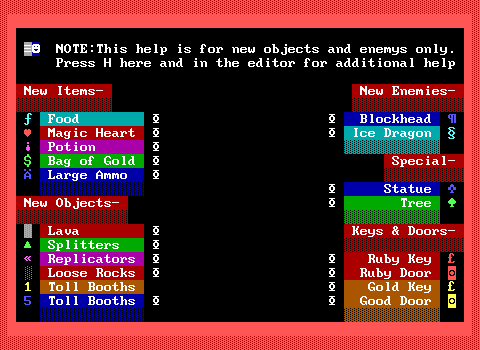
Cannibal Island maintains the non-linear structure of its ancestors, while enhancing the experience with a variety of special objects intended to contribute to the types of elements included in ZZT. You'll find magic potions of varying color and effect, lava to pair with water, splitters to turn one bullet into two, replicators to noiselessly copy blocks, toll booths that require gems to pass, and a unique "blockhead" enemy only defeatable with bombs (and uh, loose rocks). It takes what official ZZT releases before have done, and tries to expand on it in order to create something even more grandiose than before. I wouldn't be surprised if the objects in question weren't a large influence on MegaZeux's own built-ins where Janson was no longer beholden to ZZT's limitations when coding from scratch.

While Cannibal Island aims to bring ZZT to the next level with these new additions, its success is quite mixed. The effort is clearly there, and the player's journey continues to be full of slider puzzles to untangle and creatures to shoot. The player will have to tread carefully through caverns of ice, an ancient temple, a towering pyramid, and a seemingly endless forest. The boards that focus on classic ZZT gameplay are now clearly crafted by somebody that knows what they're doing. ...Even if Janson isn't shy about punishing players with unwinnable game-states when they don't tread carefully.
The special objects that are intended to create more unique gameplay scenarios don't really live up to expectations. Most of the special objects are only found on a single board each with very specific context that allows them to function. Some are a bit buggy and can end up being easily trivialized even by players not trying to do so thanks to ZZT's lack of an ability to tell what an object is being blocked by other than the player. One potion effect is to turn monsters into gems, but as it's in a dark room, players are likely to have taken out most of the monsters rather than trying to avoid them before they reach it, and that's assuming they even do manage to stumble across it in the first place.
With its Monkey Island references including cute interstitial boards for chapter breaks, and variety in locations that you'd expect to find in a 16-bit era platformer it's hard not to not enjoy the peculiar island vibe here, even if it's full of cannibals. After all, they're quite nice actually.
Caverns: Treasure of Gorn and Zap Attack: Revenge of Gorn
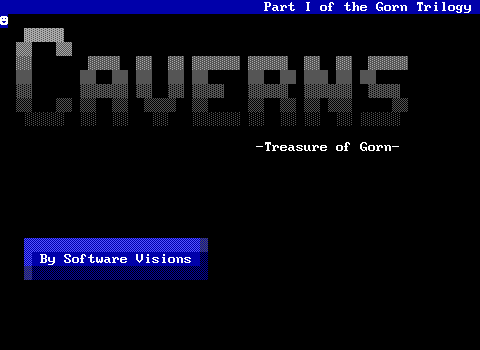

These two titles are part of an unfinished trilogy and were originally only made available as bonus games for those who registered any of the Software Visions products. While eventually made freely available, their initial lack of availability means that these two titles don't really have the historic significance the other games in this compilation have. People did register Software Visions releases and therefore were playing these games, but I don't think anybody out there was registering so they could play them.
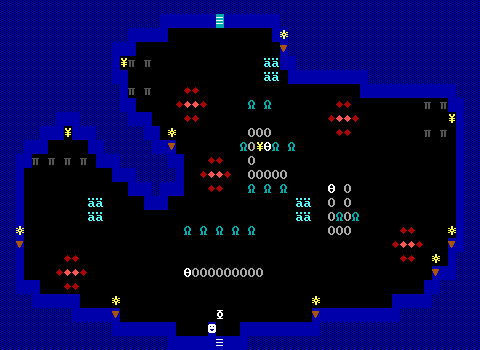
The lack of a big push for these two titles might be for the best. Both of these games are pretty short and straightforward little adventures. The effort here is considerably less than the more story driven worlds Janson would go on to release, and lacks that charm of the older titles. Instead, you get what basically amount to subtle ZZT tech demos. Normally this would mean some impressive coding for the era to demonstrate ZZT doing things that haven't been done before, but not this time. The Gorn series is more about showing off Super Tool Kit colors which depending on when registrations were received, may have been entirely new to ZZTers. Both games are loaded with alternate colors for standard elements. There are plenty of instances of gray tigers, bright cyan ammo, blinking fake walls, and other elements to go around. Depending on the exact time of release, it's quite possible these worlds may have been designed specifically to make ZZTers wonder how in the world these colors came to be.
Many ZZT worlds of 1994/1995 after STK's release share the kind of look the Gorn series has, where STK isn't used to create complex fades or moody scenes, but rather to make the lions green, turning established rules on their heads. Myth's Fred! Episode 1 and Sonic256's Merbotia are both excellent examples of this style, and it would seem Janson's own use of STK began with this more colorful, yet still quite traditional looking visual design.

Beyond the graphics and their initial rarity, these aren't games of particular note. Both are a handful of ZZT action boards with the former being set in a cave filled with treasure and the latter in Gorn's "Zap Attack Trap". You'll shoot lions and tigers, pull levers, tunnel through slime, collect treasure, and basically just do what most ZZT adventurers do. An overarching plot about the all-powerful wizard Gorn links the games together and helps provide more of a story than they would otherwise have. The boards are tough with mistakes being very costly to the player's health whether it be by getting caught in several blink walls at once or overwhelmed by ZZT's creatures.
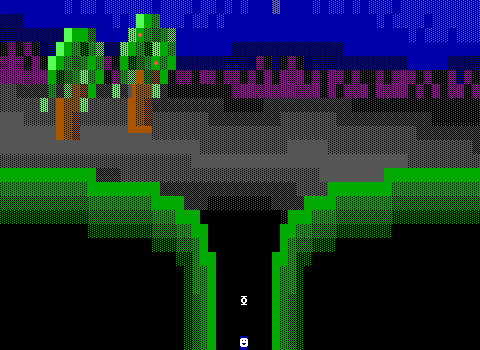
The ending sequence for the second game is impressive though, using the actual player an actor, surrounding them with objects and shoving them around as necessary for the set up for the never made finale "Pit of Chaos", which was likely shelved due to the focus on developing MegaZeux as well as creating games for it.
While they lack in both the history as well as the complexity Janson's games are known for these days, they can be a fun way to kill the time.
House of Horrors
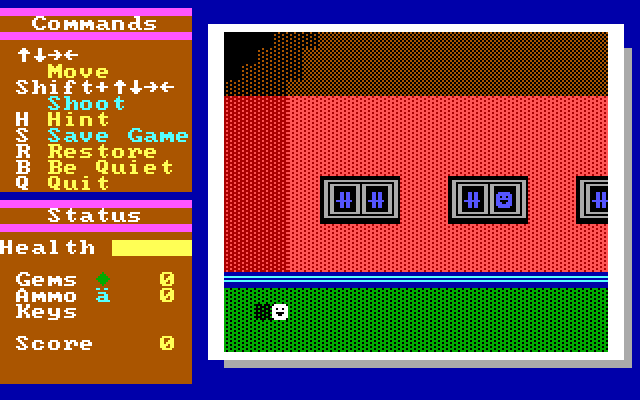
And then there's House of Horrors, Janson's sole Super ZZT release. Thanks to the limited number of Super ZZT worlds out there, this is probably one that most ZZTers dabbling in Super ZZT have checked out. Janson's name is associated with quality after all, so House of Horrors is bound to impress, right?
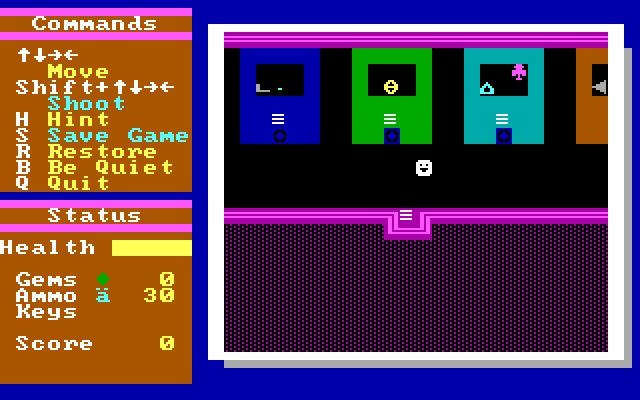
Well, maybe not. I can recall this one being fun as a kid who was enamored with ZZT engines and thus loved the arcade where the player is tasked with beating a few crude conversions of classic arcade titles. There's a horizontal shooter in "Super Galactic Flyer", a gem collecting maze chase in "Super Paka Man", a few races around various tracks in "Super Speed-Way", and the obligatory Space Invaders clone to be found in "Super Martian Invaders". The charm is certainly there, but replaying this these days really makes it clear how dire the Super ZZT situation is.
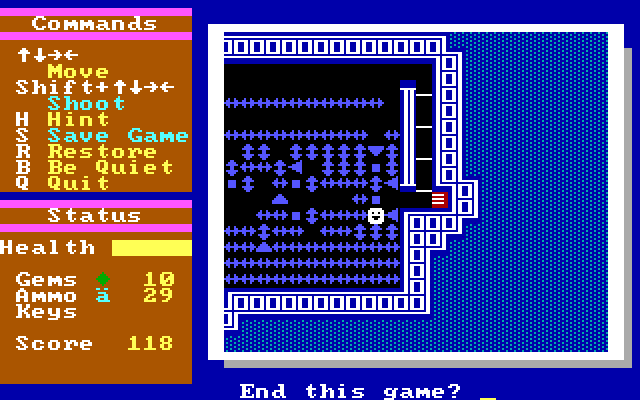
Even if it's a weak Alexis Janson game, it's still recognizably an Alexis Janson game. You'll find a challenging slider puzzle, made all the more difficult thanks to the smaller viewport afforded by Super ZZT. There's some cute oversized bosses including a giant spider and a creature made of stone. The arcade engines are simplistic, but for the era they're evidence of a competent programmer. Looking through catalogs included with Software Visions games, it seems like it took some time before this one was released, and the quality doesn't hold up with what other titles Janson had available at the time in the original ZZT. Given the lack of Super ZZT games out there, count your blessings and take look at this open house.






